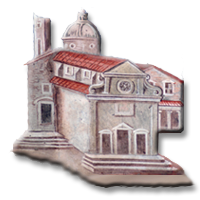This important altarpiece by Luca Cambiaso was painted for the Genoese monastery and church of Santa Brigida (Sancta Maria Scala Coeli) and was for a long time considered lost, particularly after the suppression and destruction of the church in 1890. The picture later entered the collection of the Cattaneo Adorno family in Palazzo Adorno; a building erected by Lazzaro and Giacomo Spinola between 1583 and 1588. The altarpiece is datable to Cambiaso’s mature period and may be compared most closely to another ‘sacra conversazione’ in the David and Alfred Smart Museum of Art, University of Chicago, also from the artist’s ‘golden age’.1 Both paintings have been dated by scholars to circa 1562-63 and a similar chronology is given by Soprani, who dated the present altarpiece to 1562 in his biography of Luca Cambiaso.2 Although theMadonna and Child with Saints Paul and Augustine is substantially larger than the Smart Museum painting, the two compositions are broadly similar: the Madonna and Child are enthroned in the centre and two adult saints stand at either side of them, holding their respective attributes. The formal simplification of Cambiaso’s compositions at this time is echoed in his graphic œuvre, in which the artist typically describes form through the use of simple geometric shapes. Not only does Cambiaso repeat compositional motifs in his paintings but he also adapts specific figures and their poses: here, for example, the Madonna’s head is inclined towards the Christ Child in a pose that recalls that of the Madonna in the Smart Museum painting, albeit in reverse.3 To fill the empty space beneath the Madonna and Child Cambiaso included a lamb – the symbol of Saint John the Baptist – in the Smart Museum picture and here that lamb has been replaced with a putto, whose action of reading a book (presumably the Bible) gently mimicks that of Saint Augustine beside him. The putto’s naturalistic pose was considered particularly worthy of mention by Soprani, who described the painting in great detail when it still hung in the church of Santa Brigida.4 The position of the putto’s torso and wings is almost exactly identical to that of the little angel playing with a dog in the foreground of Cambiaso’s Venus and Adonis, datable to around the same time or shortly afterwards (private collection, Genoa).5
The excellent condition of the picture surface allows us to appreciate the freedom and impasto with which Cambiaso painted this work. As noted by Torriti, the influence of 16th-century Venetian and Emilian painters is evident; the painterly surface and colourful palette recall Titian and Veronese, whilst the naturalism and elegance of the standing figures are reminiscent of the works of Correggio and Parmigianino. The broadly-painted tree that acts as a backdrop here to the Madonna and Child reappears in the background of the Smart Museum panel and in Cambiaso’s altarpiece, formerly in the church of Santa Caterina and today in the Duomo di San Lorenzo in Genoa, which was painted for Luca Spinola in 1562.6
1 Inv. 1973.50. The painting, oil on panel measuring 139.7 by 103.2 cm., was formerly in the collection of Samuel H. Kress and then the Museum of Fine Arts, Houston, before going to its present location in Chicago. Alizeri (under Literature) referred to the early 1560s, when this and the Smart Museum picture were painted, as being Cambiaso’s ‘best period’: “Ne dò il primo merito a Luca Cambiaso per la tavola di N.D. co’ Santi Paolo ed Agostino, frutto della migliore sua età, d’un disegno e d’una espressione cosí severa da fargli lode presso i dotti della Scuola Romana”.
2 See R. Soprani, ed. C.G. Ratti, under Literature.
3 This motif is taken up again by Cambiaso for his Madonna in the Madonna and Child with Saints Erasmus and Leonard in the church of San Martino, Zoagli (a detail of which is reproduced in colour in Magnani, under Literature, p. 129, fig. 136).
4 “Dipinse in oltre una tavola da Altare alle Monache di S. Brigida per la lor Chiesa; nella qual tavola effigiò Nostra Donna col Divin Fanciullo in grembo in atto di benedire i SS. Paolo, ed Agostino, a’ piedi del quale sta un’Angioletto, che legge un libro, in un atteggiamento assai naturale, e grazioso”; see Soprani, op. cit., p. 85.
5 Reproduced in B. Suida Manning & W. Suida, under Literature, fig. 113.
6 Cambiaso painted frescoes (now destroyed) and an altarpiece for the Spinola chapel in the church of Santa Caterina in Genoa in 1562; for the latter see Suida Manning & Suida, op. cit., p. 46, reproduced figs. 100 and 101 (a detail of the tree and landscape beyond) and, more recently, Magnani, op. cit., p. 132, fig. 139 (in colour).
fonte: www.sothebys.com



